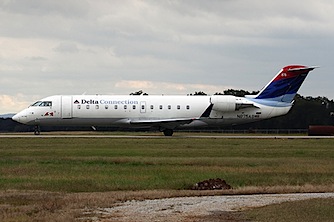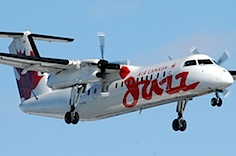RJ Nation
Boeing and Airbus may be slugging it out for dominance in the aircraft industry, but a visit to any airport, especially in the US, will tell you that the short haul or regional travel business is definitely owned by the Regional Jets (RJs). Even large hub airports like Dulles (IAD) and Newark (EWR) have entire terminals dedicated to regional carriers. These carriers mainly operate Regional Jets. Smaller airports like Greensboro, NC (GSO) are entirely dominated by Regional Jets.
For whatever reason, I am sure they had good ones, Boeing and Airbus seem to have abandoned this high growth market segment. The reason why this is a high growth segment is because major airlines are gradually turning over their low-traffic routes over to regional carriers – their ‘express’ partners. Unfortunately for us travelers, these express carriers are no longer limited to what we called ‘short-haul’ until the recent past. Heck, United has United Express servicing its Dulles – San Antonio, TX (SAT) route. I would not look forward to a 3 hour plus flight in an RJ. Most regional jets actually have a range of over 2,000 miles. 
In the RJ market too there are two major players. Bombardier from Canada and Embraer from, hold your breath, Brazil! Their jets are referred to as CRJs and ERJs respectively. The jet models have become pretty large in the recent years and in fact, the larger jets Embraer has introduced recently – the E170 AND E190 are pretty large. The E190 can have upto 98 all-economy seats. They interestingly do not even have the typical tail attached jet engines, but have jets under the wings like regular Boeings or Airbuses. Apparently, once the jets get to a certain size, you cannot attach them to the rear end of the plane and have to hang them from the wings. Some carriers even have a First Class cabins in some of these larger models. I am in fact, sitting in a First Class seat of a CRJ-700, operated by GoJet for United Express, as I type this. Not a bad First Class seat. Not as big and comfortable as a First Class seat in a regular Boeing/Airbus, but I am not complaining, especially given the fact that I was upgraded for free. Most airlines, though do not have First Class seats in their regional jets.

If there is one good thing that has come from the advent of Regional Jets, that is the demise of the prop jets. It has been a long time since I flew one (last trip I took on one was from LAX to Palm Springs (PSP), a 25 minute trip, if I remember right). I have had my fair share of rides in the old Saab Prop Jets and I am not missing them. They did not handle turbulence very well. The Regional Jets are also much faster. All jets can fly at pretty much the same speed, whether it is a large A380 or a small CRJ-200. With a cruising top speed of over 500 mph, they beat a prop jet which can only do about 400 mph, hands down.
Both Canadair and Embraer are introducing newer, larger planes in the near future. They will certainly take over more market share from Boeing and Airbus. I am sure they will also make regional travel more comfortable for us travelers.
You can also get regular updates via email or RSS by clicking on the RSS link here. Do follow us onTwitter and Facebook for updates on Airlines, Airline Miles and other Loyalty Programs.

Fortunatelty, the 50-seat RJ fleet will be shrinking. But more domestic flying will go to the larger RJs as Mainline carriers focus their operations on international and transcontinental flying. Delta had RJs flying to both coasts out of DFW throughout the 2000’s until the close of its DFW hub operation. Most regional airlines would like to have turboprops again and most mainline partners are encouraging them to do so. Skywest’s recent deal with UAL FROR for 30 large turboprops(Q400 or ATR). But Mainline partners will not make long-term commitments. In fact, because the lower altitudes are less congested and rarely have holding, and because turboprops will reach their cruise speeds faster, modern turboprops will beat Jets on flights less than 150 to 200 miles. Engines can be mounted on the fuselage of large aircraft (re MD80). I don’t know why the trend has been to mount them on the wings.
twitter.com/billwilliamsc21
Hmmm… You are right about the MD-80s having jets on the tail end. I will research to see if there is a technical reason for wing mounted jets on the E170/190s.